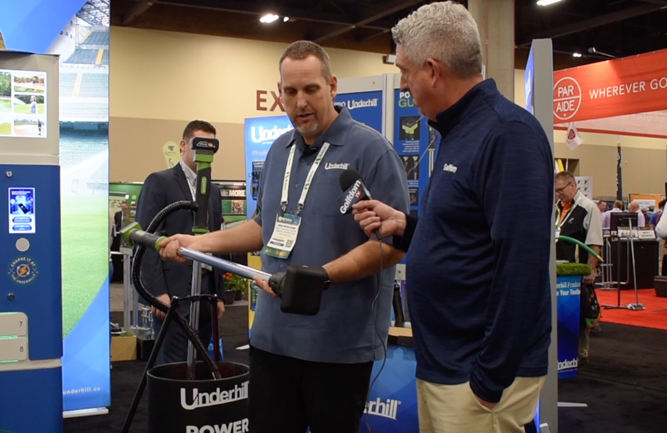SOI: Superintendents, executives enthusiastic for ’18
Golf faces many challenges, but core golfers still are passionate about the game.
Attendees of the 2017 Carolinas GCSA Conference and Show will just have to accept Executive Director Tim Kreger’s apologies if it took a little longer to find a place to sit down and have lunch this year. Business is business.
Kreger ran out of Myrtle Beach Convention Center exhibit floor space to sell to industry vendors. So, he started carving out sections of the lunch area. The Carolinas lunchroom, which normally accommodates 1,100 people, lost 600 square feet to six new vendors hungry to offer their wares to attendees.
Kreger is happy to report that it was the biggest Carolinas Conference and Show since 2007.
“If we use what happened in November as a barometer of how the industry looks here, it’s a very good sign,” he says. “There were a whole bunch of companies wanting to be seen at the show. There is money circulating in the industry right now. The people who thrive off of supplemental income are doing well — there’s a lot of renovation work being done to bunkers, greens and tees.”
In Lawrence, Kan., GCSAA CEO Rhett Evans was equally enthusiastic. The 2018 Golf Industry Show, scheduled to take place in San Antonio Feb. 3-8, has seen a 5-percent increase in booth sales from this time last year.
“Booth sales and housing are both ahead of where it was last year, so we’re hopeful that we will experience a bigger show than we did in 2017,” Evans says, while joking that, “I’ve also had a group of local superintendents guarantee me that the weather will be better (than what attendees experienced in San Antonio in 2015).”
Evans also reports that GCSAA membership is increasing, largely thanks to the growing equipment manager, assistant superintendent and student member categories. The association also is looking south of the border, to Mexico, to increase membership.
“We’re seeing the fruits of our labor,” Evans says. “We’re in a good place, and I feel strongly that 2018 will be a better year for us than 2017.”
Rounds, revenue and profit
Beyond association executives, high-level golf executives and boots-on-the-ground superintendents also agree that 2018 looks to be a good year for the industry. Golfdom’s readers were overwhelmingly positive: Nearly 75 percent of readers surveyed said they were either “very optimistic” or “slightly optimistic,” while only 7 percent were in any way pessimistic (see chart.)
David H. Robinson, CGCS, senior director, golf grounds, Marriott Golf North America, says that while he wouldn’t go so far as saying things are completely back to normal, he believes the business of golf is trending up.
“I’m very optimistic for 2018; I think we’re seeing some good indicators that things are… certainly improving. There are new courses opening in some areas. There’s the housing developments that are popping up with golf again,” Robinson told Golfdom. “As far as Marriott, we’re staying strong. If you look at our year-over-year results for the last number of years, we’ve shown some good steady growth pretty much in our three main financial factors — rounds, revenue and profit.”
Based in Orlando, Robinson was quick to call out the devastating hurricanes that hurt golf across multiple states, including his home state of Florida.
“(Hurricane) Irma really hit us hard at our Florida properties. Our property down in Naples, both courses were closed for an extended period of time,” Robinson says. “That’s going to be a pretty big hit — and it was wet in Florida. Overall, we’re going to finish the year pretty strong. We may see a slight decline in revenue and profit because of (the weather), but I think rounds are going to stay pretty strong.”
Jerramy Hainline, vice president of integrated product sales at GolfNow, oversees a sales force of 100 people working daily with golf courses. The company has evolved from a tee-time company to a service business, offering programs such as Ride, a group-buying program through Comcast that offers superintendents everything from chemicals to iron.
Hainline also is bullish on 2018, based on what he’s seeing currently among his sales team, as well as what he sees on TV and at the various golf facilities he visits.
“I’m excited. I’ve been around golf my entire life, so I’ve seen it go through many different cycles. From a macro level, the young stars energizing a different group of people is exciting. The prospect of Tiger returning is exciting,” he says. “People are interested in golf. Look no further than the alternative entry points, the non-conventional green-grass opportunities that are out there for people to experience golf, à la Topgolf. You’ll see that the people are there.”
Hainline can’t help but wonder, though, is there a way to get these potential new customers from the Topgolf facility to the country club?
“Where I get a little concerned is for traditional golf courses and their ability to adapt to what the consumer and the golfer are looking for,” Hainline says. “If they want to experience golf in a different way, what is being done by the golf course to give the people what they are looking for? As providers of an experience, this is something they need to consider.”
Slow yet steady
While golf isn’t as popular now as it was 20 years ago, Mike Fast, CGCS at Delphos Country Club in Delphos, Ohio, believes that core golfers are just as passionate about the game today as they were during the Tiger era. But he agrees with Hainline in that clubs need to be creative to attract new customers, as there simply are too many distractions (longer work hours, electronics, other sports, etc.) that can lead them away from the golf course.
To increase membership, Delphos CC hosts competitive member outings, including the Old Pal, which is a year-long, two-person, handicapped team competition. It also promotes a junior program for local high school golf teams.
“Since people aren’t hooked on golf like they used to be, you must find ways to get them to the course to spend their time and money,” Fast explains. “There are too many other things that they’ll do if you don’t.” He adds, “Through our membership programs, we should be able to maintain the membership numbers of the past couple years as we prepare for 2018.”
Of course, passion for the game varies from region to region. As one of the world’s golf capitals, Florida and its courses have no problem attracting avid golfers of all skill levels and experiences, leading clubs like Sarasota’s TPC Prestancia to renovate both of its courses. One was renovated in 2014, while the other reopened in late October. Unfortunately, the golf economy in other states is less ideal because of the nation’s economy (even though it is stabilizing). An example is Oklahoma, where the wavering price of oil and natural gas has, in turn, negatively influenced the state’s golf economy.
“We were hurting for a while, since 37 percent of our membership works in the oil and gas industry,” says Jerry Broughton, superintendent at Twin Hills Golf & Country Club in Oklahoma City. “But we are holding our membership. The economy is getting better, and new businesses will be coming here in 2018, so I’m optimistic.”
Because of the 2008 recession and its decade-long impact, many courses are forced to offer discounts. The influence of these discounts, which often are provided by third-party vendors, has been especially noticed by smaller courses, which have been forced to compete with the lower rates of larger courses.
“I don’t see an end to discounting, either, as long as the industry is still struggling,” says Lee Johnson, owner and superintendent of Sioux Creek Golf Course in Chetek, Wis. “Everyone is now being affected by lowered rates because everyone is trying to survive.”With this in mind, Jason Paradise, superintendent at Cyprian Keyes Golf Club in Boylston, Mass., is cautiously optimistic about next year’s golf economy.
“The last two seasons have been better than the previous,” he says. “We saw an uptick in public and outing rounds this year, and expect the same once again in 2018; slow-yet-steady growth.”
To read other articles included in the 2018 State of the Industry Report, click here.











